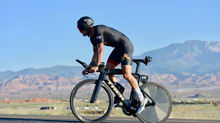HEATING UP: Summer Training & Thermoregulation
- Austin Wheat
- Jun 1
- 6 min read

Summer Training and Racing
When conditions get hot (and God forbid humid), performance tends to decline. The major contributing factors are:
Quicker muscle fatigue
Impaired cardiovascular function
Impaired central nervous system (CNS) function
Depending on intensity and duration, these factors often compound to significantly impair performance. But all hope is not lost when temperatures begin to rise. Fortunately, for endurance athletes and coaches, humans possess a unique ability to adapt to their environment as well as employ strategies to mitigate unwanted effects from summer training and racing.
This provokes, at least in my mind, an inquisitive thought: Can seasonal acclimatization lead to performance benefits? If so, how can I optimize controllables to maximize those benefits?
Heat Acclimation vs Acclimatization
Let’s start by bifurcating acclimation and acclimatization.
Acclimatization involves long-term adaptation to multiple environmental variables, like heat and humidity, and typically occurs through consistent outdoor exposure across seasons.
Acclimation refers to short-term, controlled adaptation to a single variable (typically temperature) using tools like heat suits, space heaters, or sauna sessions.
Both processes can stimulate similar adaptations, but their use cases differ. Acclimatization should be ongoing, built into spring and summer outdoor training. Acclimation is most useful during race-specific preparation or to retain performance benefits post-altitude.
Morphological and Geographic Factors
According to Bergmann’s Rule, individuals from colder climates tend to have larger, stockier builds for core heat retention. Allen’s Rule adds that people from hot climates often have longer limbs for better heat dissipation. While debatable in terms of impact on athletic performance, these adaptations can still contribute to the discussion of individual differences in thermoregulation.
Agreed upon key factors include sweat rate, body surface area, sodium intake, genetics, and heat perception. However, training status is still the most influential factor in how well an athlete performs in the heat. Coaches and athletes who understand these factors can design and execute smarter training protocols.
Heat Exposure: Adaptations and Performance Benefits
Strategic exposure to heat can be a training stimulus similar to things we know and love like intervals or long runs. Heat is a stressor and our bodies are built to adapt to stress. Key physiological adaptations from heat exposure include:
Increased plasma volume: Enhances sweat capacity without triggering cardiovascular drift and boosts stroke volume. This improves both cooling and circulatory efficiency. While heat training helps, plasma volume is most strongly influenced by overall training status, hydration, and carbohydrate availability.
Earlier onset of sweating: Meaning your cooling system activates faster, not as a crisis response.
Reduced resting and exercise core temperatures: Leading to greater work output for less strain.
Lower heart rate at a given workload: An often-overlooked benefit that shows improved efficiency.
Improved skin blood flow: Which aids in thermoregulation and systemic endurance.
Sodium adaptations: Heat exposure enhances sodium reabsorption at the sweat gland level - a physiological adaptation that improves fluid retention, hydration efficiency, and overall performance under thermal stress.
What’s striking is how these changes mirror adaptations to aerobic endurance training and altitude. In that sense, heat is an adjacent pathway for boosting resilience. But here’s the kicker: you don’t have to train hard in the heat to benefit from it. Moderate sessions or even passive exposure (think post-run sauna) can layer in additional adaptation.
The 1%: Plasma Volume, Altitude, and Elite Examples
Some athletes operate at a level where even small advantages can make a big difference. For them, heat
training can be the difference-maker for the podium or securing an FKT. Effects from heat training - like plasma volume expansion - not only improve thermoregulation but also help preserve altitude adaptations when heat exposure follows altitude training. This particular adaptation is now supported by research and embraced by elite endurance athletes.
Examples include:
David Roche heat training in cooler Boulder to prepare for Western States 100.
Anna DeMonte and Jack Kuenzle, who combined altitude camp with heat exposure for their Denali FKT attempt.
These are athletes who have maximized everything else including, but not limited to: sleep, nutrition, load management, and mental skills. As noted by Steve Magness in Science of Running, these top performers aren’t looking for magic bullets; they’re looking for new stimuli once all the foundational inputs are optimized. And heat is an effective lever.
Performance Data: Running Writings (April 2025)
A data-driven analysis of heat and marathon performance showed:
4 - 8 seconds/mile slowdown per 5°F increase in heat/humidity
Even elite runners underperform unless well-acclimated
Most performance degradation occurred in the second half of the race, confirming that early pacing and fueling are vital.
These performance drops are largely driven by fluid and sodium losses rather than temperature and humidity alone. Even a 1–2% reduction in body weight due to dehydration - approximately 1.7 lbs for a 170 lb athlete - has been shown to impair endurance performance. This supports what coaches already know: exposure creates resilience, but doesn’t eliminate risk. The heat is still a major factor even at the elite level.
The 99%: Practical Application for Most Athletes
Brass tacks - most of us aren’t looking to shave 60 seconds off a course record. We’re looking to train well, feel strong, and show up to race day prepared, not depleted. And that’s where dialing in heat strategies for real life becomes a game changer.
Key Practices by Climate
Dry Heat (e.g., Phoenix, Tucson):
Train early (before 5 AM if possible)
Use evaporative cooling: douse head, neck, hands
Wear light-colored, breathable clothing
Prioritize hydration before, during and after
Humid Heat (e.g., Southeast U.S.):
Pre-cool with ice bottles or frozen towels
Start before the dew point peaks
Prioritize hydration before, during, and after
Fueling, Hydration, and Recovery
Carbohydrates
Heat raises core temperature, heart rate, and breathing rate - all of which increase carbohydrate demand. At the same time, digestion slows, making fuel timing essential.
Before training: Start sessions with full glycogen stores
Eat a carb-rich meal 2 - 3 hours prior, or a small carb snack 30 - 60 minutes out
During training: Target 30 - 60g carbs/hour, depending on intensity and duration
Use quick-digesting forms: gels, chews, or sports drinks with glucose + fructose blend
After training: Replenish with a carb-to-protein ratio of 3:1 or 4:1 to support glycogen restoration and muscle repair
Avoid high-fat meals before training - they slow digestion and can lead to GI issues, especially in the heat. Nutrition outside of training sessions affects thermoregulation. Chronic underfueling or low energy availability can raise perceived exertion, reduce sweat rate, and impair your body’s ability to adapt to heat.
Hydration
Even a 1% body weight fluid loss can impair endurance performance. Most athletes lose 34 - 50 oz/hour in hot conditions - and some over 60 oz.
Before: Pre-hydrate the night before and drink 16 - 20 oz of fluids with electrolytes 1 - 2 hours before your session
During: The goal is to minimize net loss (not fully replace)
Use sports drinks with 4 - 8% carbohydrate concentration to hydrate and fuel simultaneously
Don’t rely solely on thirst - set a reminder to sip regularly if needed
After: Rehydrate with 1.5x the volume of fluid lost (weigh yourself pre- and post-session if possible)
Most athletes, especially during summer training or those losing more than 1L per hour, should consider high-sodium products like LMNT to support optimal rehydration.
Recovery
Heat stress continues post-exercise - it hits your CNS, immune system, and hormonal regulation.
Sleep: Aim for 7 - 9+ hours per night, especially during high-heat training blocks
Cooling: Take a cool or cold shower post-session to bring core temperature down
Next-day strategy: Adjust volume or intensity if your previous session was long, hot, or unusually taxing
It’s also important to recognize the signs of heat-related illness during and after training. Early signs include muscle cramps, dizziness, nausea, or confusion. More serious responses like heat syncope and heat stroke require immediate medical attention. Athletes and coaches should educate themselves to recognize and respond to these symptoms quickly.
In heat blocks, recovery is non-negotiable. Progress comes from adaptation, not just accumulation.
Real-World Adjustments
Long Rides: For sessions 3+ hours, start by 5 AM. Use high-output lighting: 800 - 1200 lumens front, Garmin Varia or Bontrager Flare R rear
Threshold Workouts: Shorten intervals, increase reps to maintain quality
VO2 Max: Keep rep length, add set breaks
Running: Let heart rate drift 7 - 9 bpm higher - pace by feel, not GPS
This is where most athletes should focus. We become acclimatized to the additional stress from heat and gain the performance benefits over time. By focusing on appropriate training intensities, fueling and hydrating well, and taking extra care of ourselves; we are optimizing our training inputs to maximize our adaptations from training and thus our outputs in future training and racing.
Conclusion: Focus on What Moves the Needle
Heat training has real value, but it’s only powerful when placed on top of a solid base. For elites, it’s a finetuning tool. For everyone else, the focus should be on consistently doing the fundamentals well:
Eat enough.
Hydrate intentionally.
Train smart for your environment.
Prioritize recovery.
Stay inspired by what top athletes do, but don’t forget that great performance is built by doing the simple things well over time. Own The 99%.




























